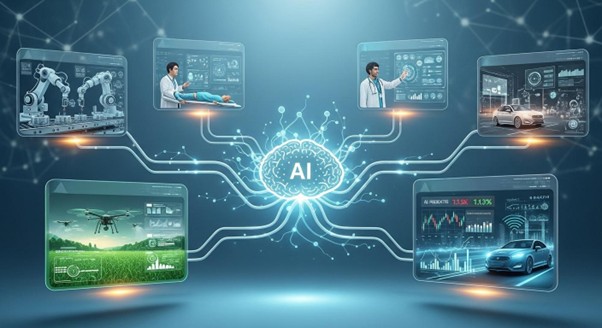
As the digital economy continues to evolve, digital transformation has become a matter of survival for modern enterprises. Yet many organizations still struggle with challenges around cost, talent shortages, and the absence of a clear roadmap. They are searching for a real “leverage point” to not only survive but to accelerate growth.
Artificial Intelligence (AI) is the answer to that challenge. AI is no longer just a tool for aut
omating workflows—it has become a core driver that defines the success of digital transformation. It empowers enterprises to analyze data, make smarter decisions, and deliver unprecedented customer experiences.
This article offers a comprehensive perspective on the role of AI in digital transformation—from practical applications to effective implementation strategies.
I. Digital Transformation: Beyond a Trend
Before exploring AI’s role, it’s important to understand what digital transformation truly means. This concept is often confused with digitization or digitalization.
Digitization: The process of converting information from physical to digital format.
Digitalization: The use of digital technology to automate or enhance existing business processes.
Digital Transformation: A comprehensive and deep change in business models, organizational culture, and customer experiences, driven by digital technologies.
According to IDC, global investment in digital transformation has already reached trillions of USD and continues to grow rapidly. This shows that digital transformation is no longer optional—it’s a mandatory path to maintaining and strengthening competitiveness.
II. AI and Digital Transformation: The Power Duo Creating Competitive Advantage
AI serves as the primary driver that accelerates and optimizes digital transformation in three key areas

1. Optimizing Customer Experience (CX)
One of the main goals of digital transformation is to enhance customer experience. AI helps businesses achieve this by:
Personalizing interactions: By analyzing user behavior, purchase history, and preferences, AI algorithms can recommend products, services, or content tailored to each individual. Amazon’s product recommendations and Netflix’s movie suggestions are prime examples that boost conversions and retention.
Automating customer service: AI-powered chatbots and virtual assistants can handle thousands of customer queries simultaneously, 24/7. This reduces the workload of support teams while providing instant responses and improving satisfaction.
2. Improving Operational Efficiency
Operational performance determines business success. AI helps streamline internal processes, reduce errors, and cut costs:
Automating repetitive tasks (RPA): Robotic Process Automation uses AI to handle repetitive tasks such as data entry or invoice processing, freeing employees to focus on higher-value work.
Optimizing supply chains: AI analyzes market data and consumer behavior to forecast demand accurately, helping businesses optimize inventory, manage logistics, and reduce transportation costs.
3. Driving Business Model Innovation
AI doesn’t just improve existing operations—it enables entirely new possibilities. This is where real breakthroughs happen:
Developing new products and services: AI leverages Big Data to uncover emerging trends, enabling companies to create unique offerings.
Creating new revenue streams: For instance, insurance companies now use AI to analyze driving behavior from IoT devices and offer personalized pricing—a completely new business model.
III. AI Applications Across Industries: Real-World Case Studies

To demonstrate AI’s effectiveness in digital transformation, let’s look at how it’s applied across industries:
Finance: Banks and financial institutions use AI to detect fraud in real time, automate credit scoring, and manage risk—reducing losses and improving lending decisions.
Retail: Leading retailers use AI to analyze customer data, optimize pricing strategies, manage inventory, and personalize both online and in-store experiences.
Healthcare: AI assists doctors in analyzing medical images (X-rays, CT scans) for earlier and more accurate diagnoses. It’s also accelerating drug discovery and clinical trials.
Manufacturing: Smart factories use AI to analyze machine data and predict maintenance needs, minimizing unplanned downtime and production loss.
While AI delivers enormous benefits, implementation is not simple. Common challenges include poor data quality, a lack of skilled professionals, and high upfront investment.
IV. Challenges and Strategies for Effective AI Implementation
However, with a strategic approach, these barriers can be overcome. Recommended steps include:
Define clear goals: Start with small, high-impact projects (Quick Wins) such as automating repetitive workflows.
Invest in data infrastructure: AI requires clean, structured, and accessible data to operate effectively.
Enhance workforce capability: Invest in internal training or partner with specialized agencies to gain deep expertise and access to advanced technologies.
Foster a culture of innovation: Encourage experimentation and calculated risk-taking to drive creativity across the organization.
Conclusion: Embracing the Future with AI
AI is no longer a futuristic concept—it’s a present-day force reshaping how businesses operate and compete. Embracing AI now means building sustainable competitive advantage and leading the market.
Successful digital transformation through AI is a long-term journey requiring commitment and a clear strategic roadmap.
Digityze Asia, with deep expertise in digital marketing and technology solutions (Martech), is committed to accompanying organizations on this journey. We deliver integrated solutions that combine advanced AI applications with multi-channel marketing—from strategic planning to execution. With dedication and cost-effective delivery, we unite technology and creativity to generate real business results.
Is your business ready for the AI and digital transformation revolution? Start today—don’t miss your moment to break through.



